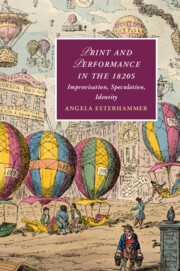Book contents
- Print and Performance in the 1820s
- Cambridge Studies in Romanticism
- Print and Performance in the 1820s
- Copyright page
- Contents
- Illustrations
- Acknowledgements
- Chapter 1 Introduction: Being There, circa 1824
- Chapter 2 Periodical Performances
- Chapter 3 Mediating Improvisation and Improvising Mediation
- Chapter 4 Personal Identity, Impersonation, and Charles Mathews
- Chapter 5 Theodore Hook’s Sayings and Doings on the Page and the Stage
- Chapter 6 Speculating on Property
- Chapter 7 Scottish Fictions of 1824
- Notes
- Bibliography
- Index
- Cambridge Studies in Romanticism
Chapter 5 - Theodore Hook’s Sayings and Doings on the Page and the Stage
“A Curious Matter of Speculation”
Published online by Cambridge University Press: 11 March 2020
- Print and Performance in the 1820s
- Cambridge Studies in Romanticism
- Print and Performance in the 1820s
- Copyright page
- Contents
- Illustrations
- Acknowledgements
- Chapter 1 Introduction: Being There, circa 1824
- Chapter 2 Periodical Performances
- Chapter 3 Mediating Improvisation and Improvising Mediation
- Chapter 4 Personal Identity, Impersonation, and Charles Mathews
- Chapter 5 Theodore Hook’s Sayings and Doings on the Page and the Stage
- Chapter 6 Speculating on Property
- Chapter 7 Scottish Fictions of 1824
- Notes
- Bibliography
- Index
- Cambridge Studies in Romanticism
Summary
Journalist, playwright, novelist, and English improvvisatore, Theodore Hook tapped into readers’ interest in representations of fashionable life with his Sayings and Doings (1824–8). Hook’s stories – influenced by his political journalism and theatrical experience and sometimes adapted for the stage – engage fundamental questions about speech, action, and personal identity. They constitute a hybrid genre of sociological documentary and imaginative fiction by an observer who stands both inside and outside the world he depicts. While William Hazlitt popularized the term “silver–fork fiction” in his reviews of Hook, the tendency to assimilate Sayings and Doings to later, longer silver–fork novels has obscured what is innovative about Hook’s fictional debut and how it embodies the distinctive climate of the 1820s. Sayings and Doings is an experimental hybrid of fiction, social critique, and metafiction that combines techniques of representation from theatre, improvisational performance, and newspaper journalism.
Keywords
- Type
- Chapter
- Information
- Print and Performance in the 1820sImprovisation, Speculation, Identity, pp. 112 - 142Publisher: Cambridge University PressPrint publication year: 2020



